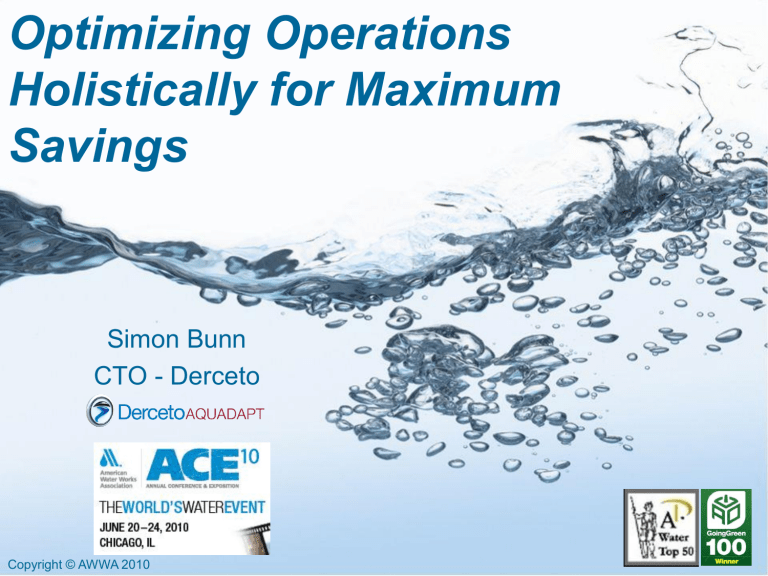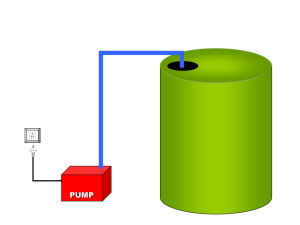the PowerPoint presentation

Optimizing Operations
Holistically for Maximum
Savings
Simon Bunn
CTO - Derceto
Copyright © AWWA 2010
Water, Energy and Sustainability
• “The more than 60,000 water systems and 15,000 wastewater systems in the United States are among the country’s largest energy consumers, using about
75 billion kWh/yr nationally —3 percent of annual
U.S. electricity consumption.“
Electric Power Research Institute,
Energy Audit Manual for Water/Wastewater Facilities,
(Palo Alto: 1999), Executive Summary
• That’s $10 billion in energy costs per year!
• “Water services are monopolistic by nature (on a local level) and are not naturally driven to increase efficiency and achieve best practices”
International Water Association (IWA) 2008
Sustainability for Water Utilities
• Water Systems use large amounts of energy.
According to some US based studies *1 , on average
80% of the marginal costs is for electricity.
• New treatment process demand higher energy levels, ozonation, UV disinfection, desalination
• Climate change introduces new issues such as droughts, reducing inflows, and flooding disrupting delivery.
• While wastewater utilities have tackled energy management via bio-gas fed generators the water utilities have made more limited steps
1. Ghimire, S. and Barkdoll,B. (2007) “Issues in energy consumption by municipal drinking water distribution systems” World environmental and water resources congress 2007 ASCE
Operations Optimization Goals
• AWWA RF Energy and Water Quality Management
System project (EWQMS) starting in 1993 with a functional specification released in 1997 defining:
◦ Interface with SCADA System
◦ State Estimator ‘Data Scrubber’
◦ Water Demand Forecaster
◦ Water Quality Module
◦ Energy Cost Calculator
◦ Pump Schedule Optimization
◦
System Monitoring & Alarms
• No complete systems delivered as of today
Why Not? The Optimization Problem
• Self modifying behaviour, starting an additional pump at a treatment plant can change pressure everywhere
• Water quality requirements, flow smoothing
• Leakage, pressure control
• Poor quality of input data (SCADA and demand)
• Reliability of outputs, pump failures, telemetry issues
• Flexibility to deal with planned and unplanned outages
• Nonlinear pump curves, 2 pumps don’t give twice the flow of one pump
With 11 pumps at ½ hour schedules there are 2^69 possible combinations, more than all the atoms in the entire universe
Need for a holistic optimizer
Able to handle
• Water quality issues
• Tariffs from Flat Time Of Use spot market
• Electricity Demand charges (peak kW or kVa) with ratchet clauses and real-time market requirements
• Treatment plant marginal cost for production, which can vary due to raw water quality, time of day etc
• Alternative pumping path options
• Non-linear pump efficiency, plus parallel pump efficiency at each pump station and globally
• Solve all pump stations together, willing to sacrifice cost at one site if overall benefit is greater system-wide
Aquadapt software
Water Utility
SCADA System
SCADA Interface
203
Current day / real-time
Data Cleaner
206
Application Manager
218
PC on LAN
Operator Panel
201
PC on
LAN
Primary Database
(Live Server)
Hydraulic Model
208
Historian
(B/U Server)
Operations Simulator
209
Dashboard
210
PC on
LAN
What does Aquadapt do?
• Interfaces directly to existing SCADA to both read input values and write pump schedules – fully automatic
• Targets five areas simultaneously:
◦ Electrical load movement in time, to maximise utilisation of low cost tariff blocks
◦ Electricity peak demand reduction.
◦ Utilisation of lowest production and chemical cost sources of water.
◦ Utilisation of shortest path between source and destination
◦
Energy efficiency improvements from pumps and pumping plants.
• Solves holistically for all costs simultaneously
Case Study 1: East Bay MUD
• System installed 2003
• Achieved 13% energy cost savings
220 MGD Average
1.3 million Customers
2 Hydroelectric Plants
3 Aqueducts ( 90 mi/147 km )
7 Water Supply Reservoirs
6 Water Treatment Plants
25 Rate Control Valves
135 Pumping Plants
180 Distribution Reservoirs
3900 Miles of Distribution Pipeline
Case Study 1: East Bay MUD
• EBMUD were already avoiding TOU tariffs
Medium Size Electric Accounts
$0.4000
20,000
16,000
12,000
8,000
4,000
-
0
$0.3000
$0.2000
$0.1000
4 8 12 16 20 24
Time of the Day
Load Electric Rates
$-
Case Study 1: East Bay MUD
• So the holistic optimizer targeted efficiency
EBMUD Aquadapt Pump Efficiency Improvements by Original Efficiency,
2003-2008
25%
20%
15%
10%
5%
0%
45 - 55% 55 - 65% 65 - 75%
Original Average Efficiency Range (%)
75 - 85%
Pump station efficiency improved universally
EBMUD Aquadapt Pump Efficiency Improvements,
2003-2008
90,0%
80,0%
70,0%
60,0%
50,0%
40,0%
30,0%
20,0%
10,0%
0,0%
Pre-Aquadapt
Post-Aquadapt
45 - 55% 55 - 65% 65 - 75%
Pump Efficiency
75 - 85%
Pumps operate more efficiently
Case Study 2: Wellington NZ
• In late 2001 New Zealand was at the end of a major drought that reduced hydro storage levels to critical low points
70% of New
Zealand’s power generation was from hydro
Case Study 2: Wellington NZ
• Greater Wellington Water contact Derceto and asked if Aquadapt could be changed to target efficiency instead of lowest energy cost.
• This merely involved changing all tariffs to a single flat tariff and removing demand charges
• Result was an immediate additional 6% reduction in kWh consumption to deliver the same water volume
• Increased energy cost overall by about 2%
• The tariff change was reversed after the crisis ended
• The public energy company thanked Greater
Wellington Water …but still charged the extra cost
Case Study 3 : Northumbrian (UK)
• Northumbrian Water provide water and sewage services to 4.4 million people in the UK
• 64 water Treatment Works
• 362 Pump Stations
• 356 Reservoirs
• Analyzed savings for this major utility using a closed loop optimization approach
• Analysis showed significant savings but UK energy rates increasing at 17% per year
• New energy provider with higher rates proposed
• What would the impact on savings be?
Case Study 3 : Northumbrian (UK)
Case Study 3 : Northumbrian (UK)
Case Study 3 : Northumbrian (UK)
Savings actually increased (but so does energy cost)
Source shift = £167,500 or 70.2%
Load shift = £71,100 or 29.8%
Method
Load + Source Shifting
Demand Reduction
Efficiency Gains
Smaller Pump Stations
Total
Original Analysis New tariff
£167,500 £238,600
£7,200
£150,000
£22,500
£7,200
£195,000
£22,500
£347,200 £463,300
•
• What if a flat tariff was introduced? • Almost no drop in savings
But what if source shifting (using different total production volumes at each treatment plant) was not possible?
• £391,700 or 84.5% as electrical load shifting increased
270% to fill the gap
Derceto AQUADAPT Utility Case Studies – USA
Aquadapt Client
WaterOne KS
Full System – May 2006
Eastern Municipal Water District CA
Stage 1 - August 2006
Eastern Municipal Water District CA
Stage 2 – September 2007
East Bay Municipal Utility District CA
Stage 1 – August 2004
Washington Suburban Sanitary
Commission MD
Full System – May 2006
Regional Municipality of Peel
*1
ON
Full System – September 2010
Gwinnett County Dept. of Water
Resources GA
Full System – December 2009
Total Utility
Population
Energy
Cost
Savings
400 k 14%
700 k
1.3 M
1.8 M
1.2 M
800 k
10%
15%
12%
11%
10%
8%
* Factory Tests Complete – Projects being installed now
Approx
Annual
Savings
$ 745 k
Efficiency
Gains
Annual GHG
Reduction
(metric ton)
6% 4,800
$120 k
$190 k
$360 k
$865 k
C$1.6 M
$460k
8%
8%
6%
8%
6%
6%
300
240
800
4,500
5,600
2,300
Conclusions
• Operations optimization and especially energy management can lead to substantial savings
• Focusing on just tariff or single pump stations can be counter productive
• A global holistic optimizer takes into account;
◦ Water quality
◦
Tariff
◦ Production costs (chemical and electrical)
◦ Constraints
• Savings are not independent, removing one area of potential savings can lead to improvements in other areas with little impact on overall savings
Thank You
Simon Bunn sbunn@derceto.com
Wes Wood wwood@derceto.com


